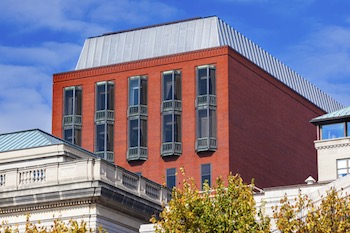 Nidec Motor Corp. v. Zhongshan Broad Ocean Motor Co., No. 2016-2321, 2017 U.S. App. LEXIS 15923 (Fed. Cir. Aug. 22, 2017) (Before Dyk, Reyna, and Wallach, J.) (Opinion for the court filed Per Curiam) (Concurring opinion, Dyk, J., joined by Wallach, J.).
Nidec Motor Corp. v. Zhongshan Broad Ocean Motor Co., No. 2016-2321, 2017 U.S. App. LEXIS 15923 (Fed. Cir. Aug. 22, 2017) (Before Dyk, Reyna, and Wallach, J.) (Opinion for the court filed Per Curiam) (Concurring opinion, Dyk, J., joined by Wallach, J.).
Nidec owns the ’394 patent, which is directed to low-noise heating, ventilating, and air conditioning systems. The invention achieves quieter operation due to improvements in the motor controller. The improved motor controller performs sinewave commutation for an alternating current, instead of a more conventional square-wave commutation.
In an IPR, Broad Ocean asserted that challenged claims were anticipated by Hideji, or obvious over the combination of Bessler and Kocybik. The Board instituted review for obviousness but not for anticipation, because Broad Ocean failed to provide an affidavit attesting to the accuracy its translation of Hideji.
Broad Ocean filed a second IPR petition, this time including the required affidavit. Broad Ocean requested that the Board join the two IPRs under 35 U.S.C. § 315(c), which allows for joinder at the discretion of the Director of the USPTO. A panel of three administrative judges again declined to institute review based on Hideji, because the second petition was time barred under § 315(b). It further held that the exception to the time bar for joinder under §§ 315(b), (c) did not apply because the statute does not permit a party to join new issues to a proceeding where it is already a party. In a rehearing by an expanded panel of five Administrative Patent Judges, Board reversed and found that § 315(c) permits the joinder of any person who properly files an IPR petition under § 311, including a petitioner who is already a party to an earlier instituted IPR. It also found that “§ 315(c) encompasses both party joinder and issue joinder, and, as such, permits joinder of issues, including new grounds of unpatentability, presented in the petition that accompanies the request for joinder.”
The expanded panel instituted review of the second petition and granted Broad Ocean’s request to join the new proceeding with the earlier-instituted IPR. The Board ultimately determined that all the challenged claims were unpatentable as anticipated by Hideji or obvious over Bessler and Kocybik. Nidec appealed.
Nidec argued that the Board improperly applied the joinder and time bar statutes. The Court held that it need not resolve this dispute because it affirmed the Board’s conclusion that all of the challenged claims are unpatentable as obvious. There was no dispute that the first petition was timely filed, and the joinder issues on appeal related only to the Board’s ruling on anticipation, which ultimately did not affect the outcome of the case.
Next, Nidec argued that the Board erred in concluding that the challenged claims would have been obvious over Bessler and Kocybik. Nidec did not dispute that the claimed elements from the ’394 patent were described in the references but asserted that the Board wrongly construed the term “HVAC system” in the claim preambles to be non-limiting. The Court rejected this argument. Regardless of the preamble, there was no dispute that Bessler taught an HVAC system as recited in the claims. Because the Court need only construe claim terms “that are in controversy, and only to the extent necessary to resolve the controversy,” it did not need to construe the preambles when the construction was not “material to the [obviousness] dispute.” Nidec also argued that Bessler taught away from the claimed combination. According to Nidec, incorporating sinewave commutation into an HVAC system increases complexity, which is contrary to the fundamental goal of Bessler. The Court disagreed, finding there was nothing in Bessler to discourage the use of sinewave commutation in HVAC systems, which Bessler did not even mention; that feature came from Kocybik. the obviousness finding was affirmed.
In a concurring opinion, Judges Dyk and Wallach addressed the PTO’s position on joinder. First, the judges explained that the exception to the time bar for “request[s] for joinder” was designed to apply where time-barred Party A seeks to join an existing IPR timely commenced by Party B when this would not introduce any new patentability issues. Here, the issue was whether the time bar allows a time-barred petitioner to add new issues, rather than belatedly joining a proceeding as a new party, to an otherwise timely proceeding. Section 315(c) does not explicitly allow this practice, and Judges Dyk and Wallach argued that it was unlikely Congress intended to allow it. Second, the judges questioned whether the practice of expanding panels in cases where the PTO is dissatisfied with a panel’s earlier decision is the appropriate mechanism for achieving uniformity of PTO decisions.
The Federal Circuit does not decide issues which have no effect on the outcome of the case. Thus, Board’s ruling that a party may add new issues to an IPR by joining two IPR proceedings was undisturbed and was endorsed in concurring opinion by two Federal Circuit judges.
[Troutman-Ad]
[Troutman-About]

![[IPWatchdog Logo]](https://ipwatchdog.com/wp-content/themes/IPWatchdog%20-%202023/assets/images/temp/logo-small@2x.png)


![[Advertisement]](https://ipwatchdog.com/wp-content/uploads/2024/04/UnitedLex-May-2-2024-sidebar-700x500-1.jpg)
![[Advertisement]](https://ipwatchdog.com/wp-content/uploads/2024/04/Artificial-Intelligence-2024-REPLAY-sidebar-700x500-corrected.jpg)
![[Advertisement]](https://ipwatchdog.com/wp-content/uploads/2024/04/Patent-Litigation-Masters-2024-sidebar-700x500-1.jpg)

![[Advertisement]](https://ipwatchdog.com/wp-content/uploads/2021/12/WEBINAR-336-x-280-px.png)
![[Advertisement]](https://ipwatchdog.com/wp-content/uploads/2021/12/2021-Patent-Practice-on-Demand-recorded-Feb-2021-336-x-280.jpg)
![[Advertisement]](https://ipwatchdog.com/wp-content/uploads/2021/12/Ad-4-The-Invent-Patent-System™.png)






Join the Discussion
No comments yet.